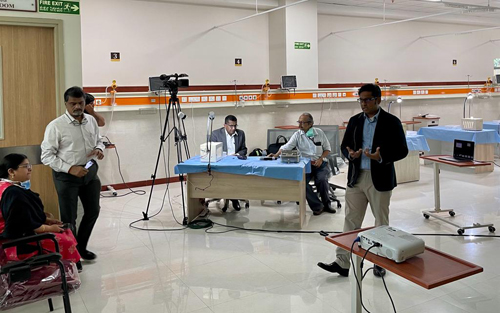Lankan doc among ‘Master Innovators’ at global summit on Ozaki procedure

Dr. Muditha Lansakkara at the 'dry lab' demo
Sri Lanka stood on par with other countries performing this complex and life-saving open heart surgery requiring skilled hands, at the first-ever ‘Ozaki Summit’ in the world held at the Sri Jayadeva Institute of Cardiovascular Sciences and Research in Bengaluru, India 2023 from May 18 to 20.
Standing alongside Dr. Shigeyuki Ozaki of Japan’s Ohashi Medical Centre who introduced this pioneering procedure to the world in 2007, were Sri Lanka’s Consultant Cardiothoracic Surgeon Dr. Muditha N. Lansakkara attached to the Kandy National Hospital; Dr. Christopher W. Baird of America’s Harvard Medical School; and Dr. Sivakumar Sivalingam of Malaysia’s National Heart Institute.
They were the ‘Master Innovators’ showcasing to other surgeons, as many as 65, how the Ozaki procedure gives standard reproducible results and could be of much benefit to patients.
While Dr. Ozaki and Dr. Baird demonstrated the techniques and skills required for the Ozaki procedure on patients, Dr. Lansakkara and Dr. Sivalingam did so in huge ‘dry labs’ where models had been set up.
Going down a pathway not tried in Sri Lanka before in October 2019, Dr. Lansakkara and his team at the Kandy National Hospital have performed 68 Ozaki procedures in the short span of four years, putting Sri Lanka within the range of the top 10 countries doing so.
The Sunday Times exclusively reported this feat back in November 2019 headlined ‘Life-saving Ozaki procedure now in Sri Lanka’ after Kandy’s pioneering team had completed four such surgeries on patients from Hatton, Galagedera, Welimada and Pilimatalawa.
The Ozaki procedure is performed for aortic valve disease which causes shortness of breath. Patients can suffer from complete dilatation (fully expansion or opening) of the heart and be susceptible to spells of giddiness as well as stroke. This condition, if not corrected, can lead to death.
In this procedure, the affected or diseased cusps are replaced by cusps formed from the patient’s own pericardium (the membrane enclosing the heart. As such, it is ‘autologous’ and the chances of rejection are nil.
The tongue-twisting medical name of the Ozaki procedure is ‘Aortic valve neocuspidization with glutaraldehyde-treated autologous pericardium’ . It can correct both aortic aortic valve stenosis — or aortic stenosis — or aortic regurgitation or a mix of both.
In aortic stenosis, the valve between the lower left heart chamber and the body’s main artery (aorta) is narrowed and does not open fully. This reduces or blocks blood flow from the heart to the aorta and to the rest of the body.
In aortic regurgitation, there is inadequate closure of the aortic valve when the heart muscle relaxes and allows the chambers to fill with blood. This causes a reverse blood flow through the aortic valve.
Dr. Lansakkara makes the steps of the Ozaki procedure seem easy:
- The patient is put to sleep (put under general anaesthesia) and the chest is opened up through a midline sternotomy (cutting through the sternum or breastbone).
- A 7X8 cm piece of the pericardium is dissected. It is then placed in 0.6% of glutaraldehyde for 10 minutes and washed in saline thrice for six minutes each time.
- The patient, meanwhile, is cannulated and attached to the heart-lung (cardiopulmonary bypass) machine to allow for cardioplegia (the intentional and temporary cessation of the heart).
- The team then cuts into the proximal aorta to reach the aortic valve. Depending on the need, the diseased cusps of the aortic valve are excised. Some patients may have aortic valve stenosis, while others could be having bicuspid valves (two instead of three cusps) due to congenital calcification and narrowing of the aortic valve.
- The skill lies in moulding or fashioning three cusps from the harvested pericardium after getting the precise sizes needed by a particular patient. Thereafter, these cusps are fixed to the natural annulus (ring-shaped structure) of the aortic valve outlet. This is what helps the aortic valve to function naturally without leaking.
The advantages of the Ozaki procedure are: The patient’s own tissues are used, the 3-D configuration of the valve is maintained and the orifice of the aortic valve area is maximally used without narrowing. The patient gets only aspirin for about six months.
Searching for an ideal partner? Find your soul mate on Hitad.lk, Sri Lanka's favourite marriage proposals page. With Hitad.lk matrimonial advertisements you have access to thousands of ads from potential suitors who are looking for someone just like you.


